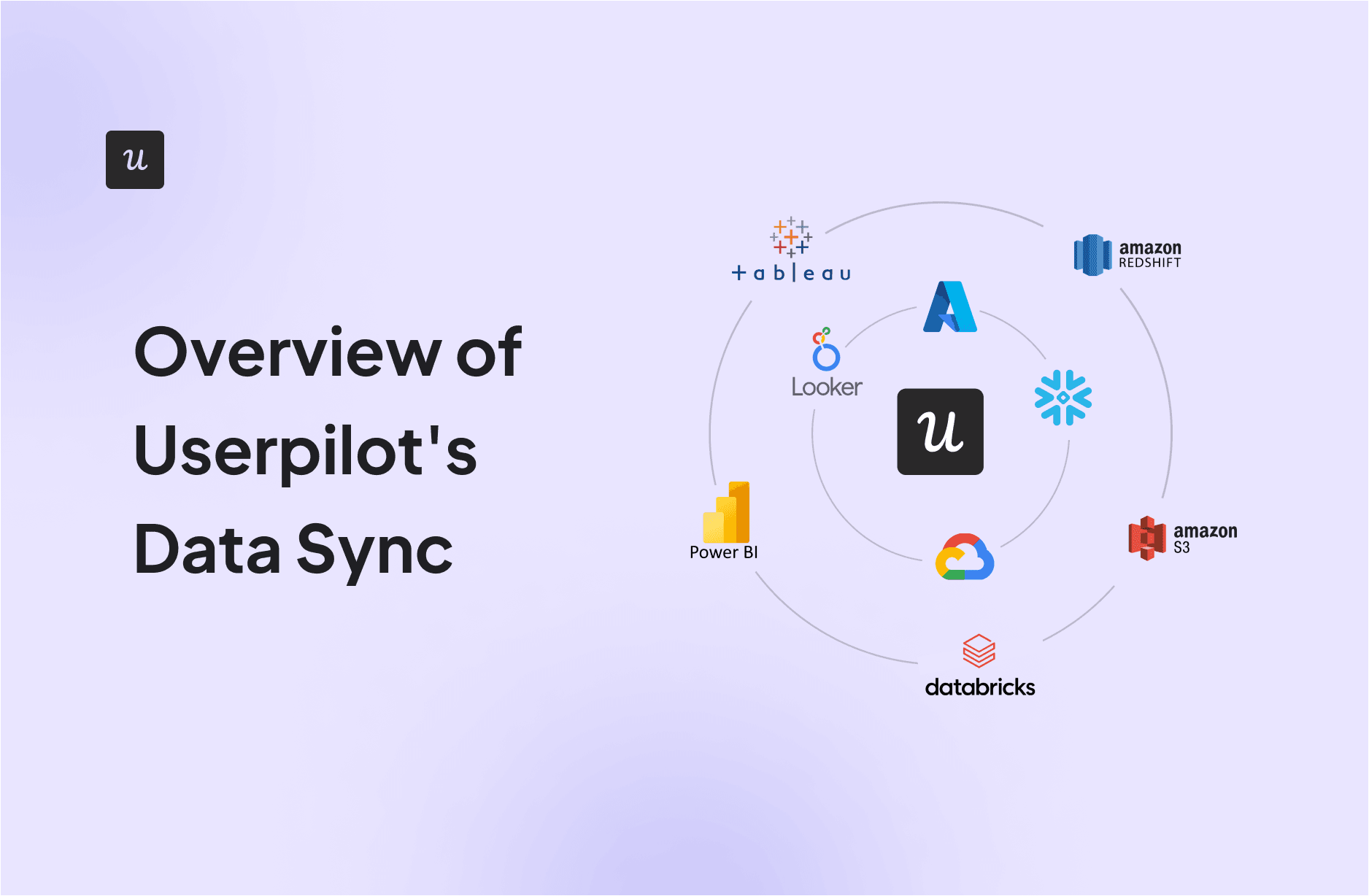
In the race for product-led growth, your product teams are probably drowning in data they can't effectively use.
Consider this: When your product manager spots a concerning drop in feature adoption, your customer success team might be simultaneously celebrating high engagement scores – simply because they're looking at different data sets. These disconnects aren't just frustrating; they're costing you growth opportunities.
That’s why, as a leading all-in-one product growth platform we developed a solution to help you break data siloes. Userpilot's new data sync feature tackles this fragmentation head-on by creating a single source of truth that automatically updates across all your systems.
Try Userpilot Now
See Why 1,000+ Teams Choose Userpilot

How Userpilot’s data sync simplifies the process
Userpilot offers a simple way to unify product and business data and use these insights to predict churn, revenue, customer health scores, and other key metrics.
With our data synch feature, it’s easy to ensure data consistency across systems, all you have to decide on is sync frequently, and data will be automatically updated in a couple of hours.
After collection, data is automatically transferred to cloud storage platforms (Amazon S3, Google Cloud, Microsoft Azure) where it undergoes thorough Extract, Transform, Load (ETL) processing. This cleaned and organized data is then stored in data warehouses like Amazon Redshift, Snowflake, or Databricks, ensuring data integrity and accessibility.

How Userpilot’s data sync enables smarter decision-making across teams
Each team has its distinctive way of approaching data-driven decision-making. With Userpilot’s data sync, organizations can break down data silos and create a single source of truth for all teams, which lets them make confident, data-informed decisions while maintaining focus on the complete customer journey.
Here's how different teams can use Userpilot's data sync feature to make smarter decisions:
- Customer-facing teams can build comprehensive user journeys by combining data from sales, marketing, and support channels. This unified view helps them understand the complete customer lifecycle from initial contact through ongoing engagement. Having access to contextual business data lets customer-facing teams provide more personalized support and deliver a consistent experience across all customer touchpoints.
- Product leaders can gain a holistic view of multiple product lines through integrated analytics tools. They can track visitor analytics across different product segments and coordinate development efforts based on unified product performance data.
- CS teams can develop more sophisticated customer health scores by combining multiple data sources. By blending NPS data with historical account data, they gain deeper insights, create a contextual understanding of user sentiment, and identify early warning signs of customer dissatisfaction.
- Customer success teams can create onboarding based on where users are getting stuck in the product.
Ready to get a single source of truth for all your tools? Book a personalized demo today to see how Userpilot's data sync can help you streamline your data management and optimize your product experience.
FAQs about Userpilot data synch feature
What does it mean to synchronize data?
Data synchronization is an automated process of democratizing data between multiple sources, ensuring consistency and accuracy across all platforms. This eliminates manual data management tasks while maintaining data quality throughout your systems.
What platforms does Userpilot integrate with?
Userpilot integrates with several leading platforms to enable data transfer and smart decision-making. These tools include:
- Salesforce (Enterprise plan): A two-way integration for sharing survey responses, events data, and product engagement metrics. Allows targeted campaigns and improves lead scoring based on product usage.
- HubSpot (Growth & enterprise plan): Provides two-way integration for creating targeted segments and personalizing experiences using contact properties and in-app behavior data.
Available across all plans:
- Google Analytics: One-way integration combining website analytics with in-app engagement data.
- Zendesk: One-way integration for seamless in-app help center access.
- Twilio Segment: Two-way integration enabling unified user activity tracking across the Segment ecosystem.
- Google Tag Manager: Direct installation and two-way data sharing for targeted experiences.
- Intercom: One-way integration for tracking user engagement within Intercom profiles.
- Analytics Suite: Two-way integrations with Mixpanel, Heap, and Amplitude for comprehensive analytics and user behavior tracking.
Is coding expertise required to use Data Sync?
No, coding expertise is not required to use Userpilot's Data Sync feature. Userpilot is designed with user-friendliness in mind.
How does Userpilot ensure data security during sync?
Userpilot adheres to data protection regulations and industry standards like GDPR and CCPA, which ensures that secure data handling protocols are in place during sync operations. Here’s how:
- Data in Transit: Userpilot uses TLS (Transport Layer Security) encryption to secure customer data during transmission. This ensures that any data exchanged between the Userpilot service and client systems is encrypted, protecting it from interception or unauthorized access.
- Data at Rest: Data stored on Userpilot’s servers is encrypted using strong encryption standards (e.g., AES-256), ensuring its safety even if physical access to the servers is compromised.
- Security Audits: Regular internal and third-party security audits identify and mitigate vulnerabilities in the synchronization process.
FAQ
What does it mean to synchronize data?
Data synchronization is an automated process of democratizing data between multiple sources, ensuring consistency and accuracy across all platforms. This eliminates manual data management tasks while maintaining data quality throughout your systems.
What platforms does Userpilot integrate with?
Userpilot integrates with several leading platforms to enable data transfer and smart decision-making. These tools include:
- Salesforce (Enterprise plan): A two-way integration for sharing survey responses, events data, and product engagement metrics. Allows targeted campaigns and improves lead scoring based on product usage.
- HubSpot (Growth & enterprise plan): Provides two-way integration for creating targeted segments and personalizing experiences using contact properties and in-app behavior data.
Available across all plans:
- Google Analytics: One-way integration combining website analytics with in-app engagement data.
- Zendesk: One-way integration for seamless in-app help center access.
- Twilio Segment: Two-way integration enabling unified user activity tracking across the Segment ecosystem.
- Google Tag Manager: Direct installation and two-way data sharing for targeted experiences.
- Intercom: One-way integration for tracking user engagement within Intercom profiles.
- Analytics Suite: Two-way integrations with Mixpanel, Heap, and Amplitude for comprehensive analytics and user behavior tracking.
Is coding expertise required to use Data Sync?
No, coding expertise is not required to use Userpilot’s Data Sync feature. Userpilot is designed with user-friendliness in mind.
How does Userpilot ensure data security during sync?
Userpilot adheres to data protection regulations and industry standards like GDPR and CCPA, which ensures that secure data handling protocols are in place during sync operations. Here’s how:
- Data in Transit: Userpilot uses TLS (Transport Layer Security) encryption to secure customer data during transmission. This ensures that any data exchanged between the Userpilot service and client systems is encrypted, protecting it from interception or unauthorized access.
- Data at Rest: Data stored on Userpilot’s servers is encrypted using strong encryption standards (e.g., AES-256), ensuring its safety even if physical access to the servers is compromised.
- Security Audits: Regular internal and third-party security audits identify and mitigate vulnerabilities in the synchronization process.






